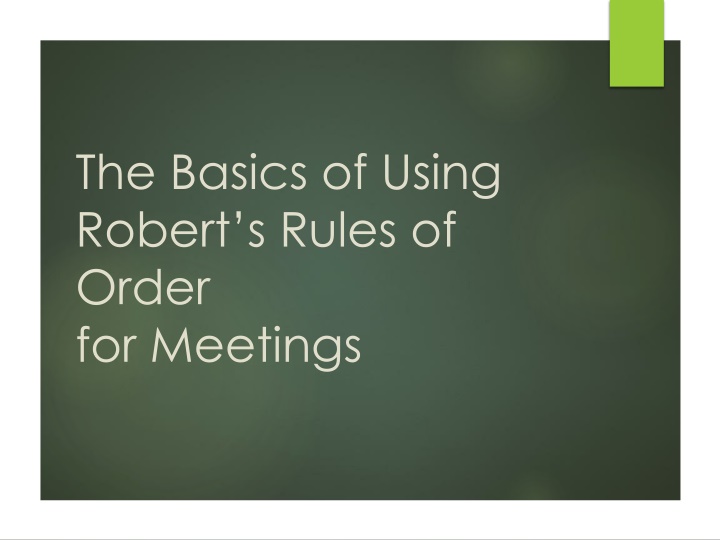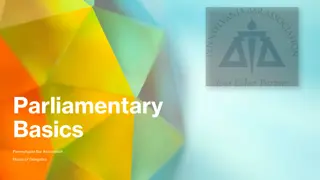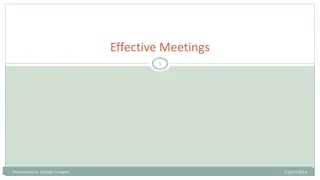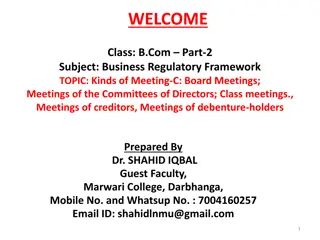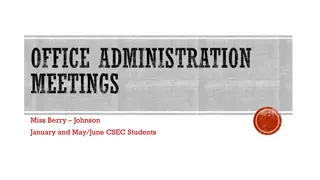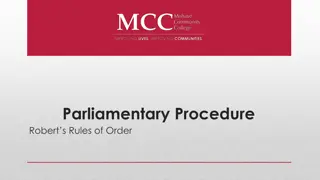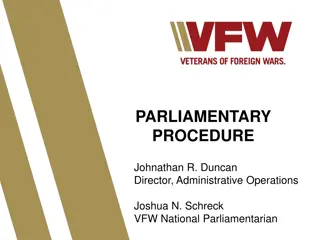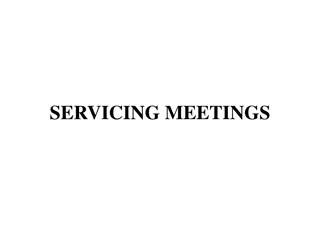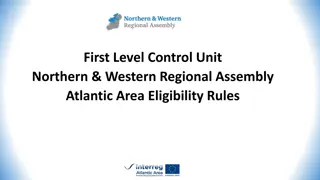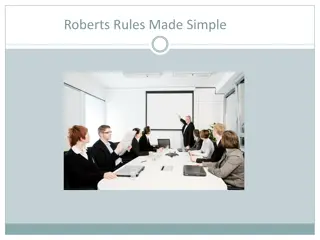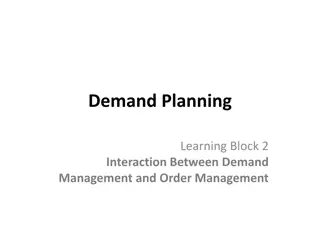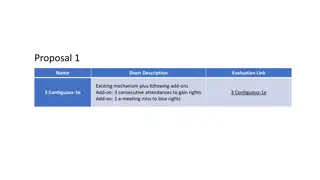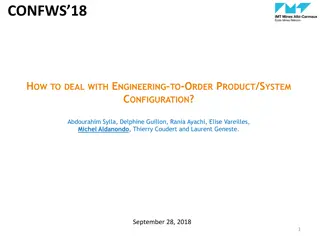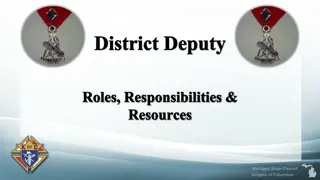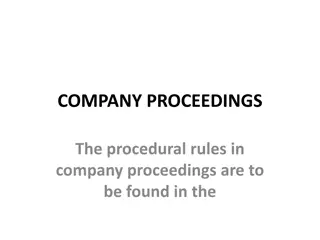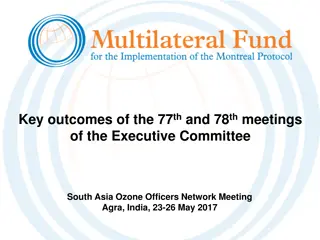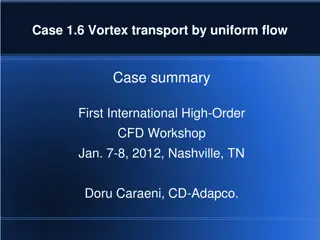Mastering Robert's Rules of Order for Effective Meetings
Learn the key principles of Robert's Rules of Order to conduct meetings successfully. Understand the importance of protecting the rights of all members, the significance of quorum, decision-making processes, debate etiquette, and the role of the meeting chair for efficient discussions. Follow these rules to ensure orderly and productive meetings every time.
Download Presentation

Please find below an Image/Link to download the presentation.
The content on the website is provided AS IS for your information and personal use only. It may not be sold, licensed, or shared on other websites without obtaining consent from the author.If you encounter any issues during the download, it is possible that the publisher has removed the file from their server.
You are allowed to download the files provided on this website for personal or commercial use, subject to the condition that they are used lawfully. All files are the property of their respective owners.
The content on the website is provided AS IS for your information and personal use only. It may not be sold, licensed, or shared on other websites without obtaining consent from the author.
E N D
Presentation Transcript
The Basics of Using Robert s Rules of Order for Meetings
Meetings Uses Roberts Rules of Order - Revised Meetings that use Robert s Rules of Order Run in the same manner No matter where the meeting is held
Purpose of RRO Based on common sense and logic The rules protect: (a) the rights of the majority to decide (b) the rights of the minority to be heard (c) the rights of individual members (d) the rights of absentees
The Ten Basic Rules 1. The Rights of the Organization Supersede the Rights of the Individual Members 2. All members are equal and their rights are equal 3. A quorum must be present to do business
The Ten Basic Rules 4. The majority rules All questions at any legally convened meeting shall be decided by simple majority of the votes cast, unless stipulated otherwise in the Constitution. 5. Silence means consent Those members that do NOT vote AGREE to go along with the decision of the majority by their silence. 6. Two-thirds vote rule A 2/3rds vote is necessary whenever limiting or taking away the rights of members or changing a previous decision.
The Ten Basic Rules 7. One question at a time and one speaker at a time. Motions must be related to matters under consideration 8. Once a member has been recognized this individual has been granted the floor and may not be interrupted by another member Motions must receive full debate 9. The meeting chair may not put a motion to vote as long as members wish to debate it The debate can only be cut short by a 2/3rds vote
The Ten Basic Rules 10.Once a decision made, an identical motion must not be brought forward at the same meeting Such a motion shall be ruled out of order by the meeting chair BONUS! 10.Personal remarks in a debate are ALWAYS out of order Debate Motions not Motives Debate must be directed to Principles and not Personalities
CHAIR CHARACTERISTICS In control of the floor Impartial Composed Precise: restates motions before votes Focused: stays on track with discussions Temperate: uses the gavel sparingly Running a Meeting Effectively ON TIME AND STAYS ON TIME ORGANIZED AND PREPARED PREPARED: KNOWS THE RULES AND BYLAWS A PARLIAMENTARIAN: KEEPS THE GROUP WORKING TOGETHER
Keeping Minutes Minutes are the written record of the meeting Minutes are the permanent and legal record of the meeting They should be written as concisely as possible Secretary s duty
Keeping Minutes Approval of Minutes At each meeting, review minutes from prior meeting Allow for corrections Reminder to members of previous decisions and discussions
Motions A motion is a formal proposal for consideration and action. Only one motion can be made at a time, No main motion can be made while the body is already considering a prior motion. Motion procedure: Motion is made ( I move that ) Motion is seconded Motion is debated/discussed Motion is voted on
8 Steps in Processing a Motion 1. When nothing else is pending, a member will address the Chair or raise their hand. Say Chair ____. 2. Chair recognizes the member by stating their name or otherwise acknowledging them. Chair says: Member ____.
8 Steps in Processing a Motion 3. Member will state their motion. Say I move that ____. 4. Another member seconds the motion. Other member raises their hand and says Second. Sometimes seconds are not needed I suggest it.
8 Steps in Processing a Motion 5. Chair will re-state the motion and open discussion. Chair says: It is moved that ____. Is there any discussion? 6. Members now have the right to be recognized and debate the motion. During discussion, subsidiary motions (amend, refer, etc..) may be introduced. Debate occurs in order: Pro, Con, Pro, Con, until debate is called for end or time is debleted.
8 Steps in Processing a Motion 7. The Chair will now re-state the motion and put the question to a vote. The question on the table is on the adoption of ____. All in favor say Aye , all opposed say Nay . 8. The Chair will announce the results and transition to the next order of business. The motion is carried [lost]; We will [Will not] The next order of business is
Types of Motions 1. Main Motion Brings new business before the body. 2. Subsidiary Motion Changes how a motion is handled. 3. Privileged Motion Concerns matters of high importance that are unrelated to the pending business. 4. Incidental Motion Provides a means of questioning procedure.
Frequently Used Motions. 1. Amend Used to insert or strike out words. Clarifies or improves the original motion. Must be germane to the original motion. 2. Call for the Orders of the Day Demands a return to the order of business. 3. Commit or Refer Refers a question to committee.
Frequently Used Motions. 4. Lay on the Table Temporarily suspends further action on a question. 5. Limit/Extend Debate Modifies rules of debate to allow for more/less time. 6. Postpone Indefinitely Rejects a main motion without bringing it to a vote. Allows bodies to reject motions without taking an official position.
Frequently Used Motions 7. Reconsider Can re-open debate on a closed question. Motion can only be made in the same meeting by a member of the prevailing side who has changed their mind. Can also be used to reconsider a question if it is discovered an illegal action has been taken. 8. Suspension Allows the lawful violation of certain rules. Must be clearly specified.
Asking Questions (interpreting cow motions) 1. Parliamentary Inquiry A question to the chair, to clarify some aspect of parliamentary rules or procedure. 2. Point of Information A question pertaining to the matter at hand. Directed to the chair, or to another member through the chair.
Voting There are 3 voting responses: In Favor: You approve of adoption of the question Not in Favor: You disapprove of the adoption of the question. Abstention: You withdraw from the vote. Abstention is only in order if there is a distinct conflict of interest, or if the member is not well enough informed (through prior absence or some other extenuating circumstance) to make an educated decision.
Types of Votes Vocal Vote Ayes or Nays. If the majority is unclear, a hand vote is necessary. Hand Vote The extension of the hand to indicate approval/disapproval. Roll Call Vote The Secretary proceeds through the roll call list and records each member s vote individually. Unanimous Consent An automatic approval of a question, pending no objections. If even one member objects, the chair must state the question and proceed through normal voting processes.
Questions? References: Robert s Rules of Order, 11th edition Newly Revised. Published 2012, De Capo Press. Pollack, A. & Scalice, N. Parliamentary Procedure Workshop, FAU Student Government. 2009.
